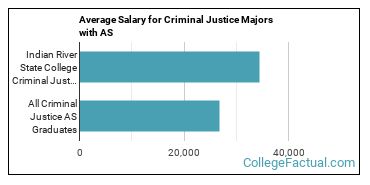 by our College Data Analytics Team
by our College Data Analytics TeamThe main focus area for this major is Criminal Justice. For more details on this concentration, visit its profile page.
Criminal Justice & Corrections is a major offered under the homeland security, law enforcement and firefighting program of study at Indian River State College. Here, you’ll find out more about the major associate degree program in criminal justice, including such details as the number of graduates, ethnicity of students, related majors and concentrations, and more.
If there’s something special you’re looking for, you can use one of the links below to find it:
Learn about start dates, transferring credits, availability of financial aid, and more by contacting the universities below.
Gain a solid foundation in the American justice system, criminal law and social science when you earn your associate degree in criminal justice online from Southern New Hampshire University.
During the 2019-2020 academic year, part-time undergraduate students at Indian River State College paid an average of $390 per credit hour if they came to the school from out-of-state. In-state students paid a discounted rate of $104 per credit hour. The following table shows the average full-time tuition and fees for undergraduates.
| In State | Out of State | |
|---|---|---|
| Tuition | $2,496 | $9,360 |
| Fees | $268 | $841 |
| Books and Supplies | $1,000 | $1,000 |
Learn more about Indian River State College tuition and fees.
You may also want to consider how much in student loans you’ll need when thinking about the overall cost to attend a school. Criminal Justice students who received their associate degree at Indian River State College took out an average of $8,000 in student loans. That is 57% lower than the national average of $18,566.

criminal justice who receive their associate degree from Indian River State College make an average of $34,420 a year during the early days of their career. That is 29% higher than the national average of $26,761.

If you’re interested in online learning, you’re in luck. Indian River State College does offer online classes in its criminal justice associate degree program. To see if the school offers distance learning options in other areas, visit the Indian River State College Online Learning page.
Of the students who received their associate degree in criminal justice in 2019-2020, 43.8% of them were women. This is less than the nationwide number of 50.8%.

Racial-ethnic minority graduates* made up 47.9% of the criminal justice associate degrees at Indian River State College in 2019-2020. This is lower than the nationwide number of 56%.

| Race/Ethnicity | Number of Students |
|---|---|
| Asian | 1 |
| Black or African American | 5 |
| Hispanic or Latino | 16 |
| Native American or Alaska Native | 0 |
| Native Hawaiian or Pacific Islander | 0 |
| White | 24 |
| International Students | 0 |
| Other Races/Ethnicities | 2 |
Criminal Justice & Corrections students may decide to major in one of the following focus areas.
| Focus Area | Annual Graduates |
|---|---|
| Criminal Justice | 48 |
You may also be interested in one of these majors related to criminal justice and corrections.
| Related Major | Annual Graduates |
|---|---|
| Fire Protection | 26 |
| Homeland Security | 1 |
View All Criminal Justice & Corrections Related Majors >
*The racial-ethnic minorities count is calculated by taking the total number of students and subtracting white students, international students, and students whose race/ethnicity was unknown. This number is then divided by the total number of students at the school to obtain the racial-ethnic minorities percentage.
More about our data sources and methodologies.